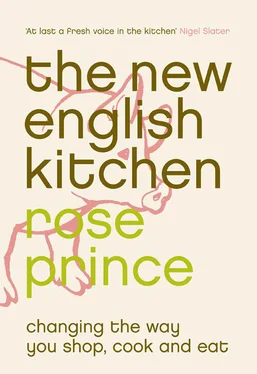Serves 2
1 tablespoon oil
1 tablespoon green curry paste
1 red pepper, cut into 1cm/ 1/ 2inch squares (optional)
2cm/ 3/ 4inch piece of lemongrass, outer layers removed, then
very thinly sliced
2cm/ 3/ 4inch piece of fresh galangal, crushed, or fresh ginger
2 fresh or dried lime leaves
250ml/8fl oz canned coconut milk, or 4cm/1 1/ 2inches cut from
a block of coconut cream and broken into 250ml/8fl oz water
2 helpings of cooked basmati rice (see here)
leaves from 4 sprigs of mint or basil
salt
Put the oil in a saucepan with the curry paste and heat through. Add the red pepper, if using, plus the lemongrass, galangal and lime leaves, followed by the coconut milk. Bring to the boil and simmer for 3 minutes. Add the rice and bring back to the boil, then stir in the herbs and season with salt to taste. Tip into bowls and eat with a spoon.
aubergine and pumpkin seed rice
When I want a warm and filling lunch that will not see me slump fast asleep over my desk mid afternoon, I heat a little cooked rice in a pan with some cooked vegetables, cumin and a few nuts or seeds. I eat it with plain yoghurt – there is usually some in the fridge – and a teaspoon of bought harissa, the hot pepper sauce of North Africa. The fresh ingredients in the following recipe could be replaced by tomatoes, shallots, spring greens, squash or pumpkin.
Serves 2
3 tablespoons olive oil
1 aubergine, diced
1 onion, chopped
2 celery sticks, chopped
1 tablespoon green pumpkin seeds
1 teaspoon ground cumin
2 tablespoons stock or water
2 helpings of cooked basmati rice (see here)
leaves from 2 sprigs of mint
salt and freshly ground black pepper
Heat the oil in a pan and add the aubergine, onion and celery. Cook, stirring, until the aubergine is soft, then add the pumpkin seeds, cumin and stock or water. Mix in the rice and reheat thoroughly. Add the mint and season to taste.
 For a richer, sweeter dish, substitute sherry for the stock or water.
For a richer, sweeter dish, substitute sherry for the stock or water.
A recipe for pilaff using cold cooked rice and leftover roast lamb can be found on here 202.
We made this for a big Christening party recently and agreed that kedgeree is hard-to-beat party food. The bare bones can be made in advance and assembled just before everyone arrives. It’s also incredibly rich. A little fish goes a long way in kedgeree, which is an advantage with the high price of sustainable fish. For information on how to choose fish, see here.
Serves 8–12
480g/1 lb smoked fish fillet – haddock, pollack or hot-smoked
organic salmon (see the Shopping Guide)
1 onion, cut in half
6 cardamom pods, crushed
250ml/8fl oz creamy milk
90ml/3fl oz single cream
1 quantity of cooked basmati rice (see here)
180g/6oz cooked peeled North Atlantic prawns (optional)
1cm/ 1/ 2inch piece of fresh ginger, grated
1 teaspoon cumin seeds, toasted and ground in a pestle and mortar
6 fennel seeds, toasted and ground as above
1/ 2teaspoon ground turmeric
30g/1oz butter, melted
4 semi-soft boiled eggs (see here), peeled and quartered
8 sprigs of coriander, chopped
Put the fish in a pan with the onion and cardamom pods and pour over the milk and cream. Place over a medium heat and bring up to boiling point. Turn down to a simmer and cook for 5 minutes, or until the fish begins to firm up and flake apart (if you are using hot-smoked salmon, you will not need to cook it – just bring to the boil). Strain off the creamy milk and reserve.
Break the fish into large flakes, discarding any skin or bones, and mix lightly with the rice and prawns. Add the remaining spices, pour over the reserved creamy milk and the melted butter and mix quite thoroughly. Strew the eggs on top and scatter over the coriander.
rice, cucumber and dill salad
The herbs lend their aromas, the onion seed gives a sharp little kick and the cucumber cools down this salad. It will not spoil if you take it to work in a carton. It’s also very good eaten outdoors, with barbecued sardines or lamb.
Serves 2
2 helpings of cooked basmati rice (see here)
4 tablespoons extra virgin olive oil
juice of 1/ 2lemon
a pinch of sea salt
1/ 2cucumber, cut in half lengthways, then peeled, deseeded
and sliced
4 sprigs of dill, chopped
4 sprigs of chervil, if available, or flat-leaf parsley, torn into
smaller sprigs
1/ 2teaspoon black onion seeds (nigella)
freshly ground black pepper
Put the rice in a deep bowl, add the oil, lemon juice and salt and mix well. Add a little more oil if you want a wetter salad. Add the cucumber and dill and mix again. Strew the chervil leaves on top. Throw over the onion seeds and finish with a grind or two of black pepper.
There are various traditional risotto recipes in the Stock chapter (see here) but here is the store-method recipe.
This technique is used in very busy Italian restaurants that want to be able to make a genuine risotto in 15, not 30, minutes. Although it is frowned upon by purists, it is very useful for anyone who works long hours.
1 tablespoon butter
1 onion, finely chopped
300 g/10 oz short grain Italian rice, such as Arborio
1 glass of white wine (optional)
1–1.5 litres/1 3/ 4–2 1/ 2pints chicken, vegetable or beef stock
Melt the butter in a large pan, add the onion and cook until soft. Add the rice and cook, stirring (preferably with a wooden fork), for 1 minute. Stir in the glass of wine, if using. When it has been absorbed, begin to add the stock a ladleful at a time, stirring constantly over a medium heat. After 10–15 minutes, taste the rice – it should be half cooked, with a white, opaque centre. Strain it, reserving any cooking liquor. Cool the cooking liquor, add it to the remaining stock and store in the fridge, clearly marked. Spread the rice out on a plastic tray, no more than 2cm/ 3/ 4inch deep. Allow to cool, cover with cling film and store in the fridge. It will keep for 2–3 days.
To finish the risotto, cut a piece of the rice from the tray – as much as you need – and put it in a pan. Cover with just enough of the cooking liquor to make it sloppy when stirred. Bring to the boil, then turn down the heat and cook gently for a few minutes, until the rice is tender but firm to the bite – al dente . Do not stir. The risotto should be cooked perfectly and ready for Parmesan or a grated hard ewe’s milk cheese, plus any other ingredients (see the recipes herefor risotto inspiration).
Leftover risotto can be shaped into little cakes – a cube of mozzarella hidden inside – then dipped first in flour, then beaten egg, then dried breadcrumbs. Shallow-fry them in a little olive oil and eat as a lunch dish, with a lush green salad.
couscous, bulgar and other grains
This is my sister Sam’s domain. She runs Moro, the Moorish-influenced London restaurant, with her husband, Sam, and they know more about grains and allied North African dishes than I can shake a stick at. But in the New English Kitchen, where your pricy piece of meat is reserved for special occasions, grains provide diversity – a lively change from rice. Use whole durum wheat (sometimes sold as pasta wheat or Ebly) in broths (see here) and salads, and use grains such as bulgar wheat (cracked whole wheat) and couscous (grains of semolina paste made from durum wheat) in salads with herbs. If you have the chance, buy your grains – along with wonderfully fresh nuts, juicy dried fruits and big bunches of herbs – from Middle Eastern shops. They usually do good bulk deals and take great pride in the quality of these essential goodies. Middle Eastern shops also sell a finer version of bulgar, the true grain to use in a tabbouleh salad with parsley, oil and lemon juice. Couscous is usually sold pre-cooked in the UK, and needs only moistening with water.
Читать дальше

 For a richer, sweeter dish, substitute sherry for the stock or water.
For a richer, sweeter dish, substitute sherry for the stock or water.










